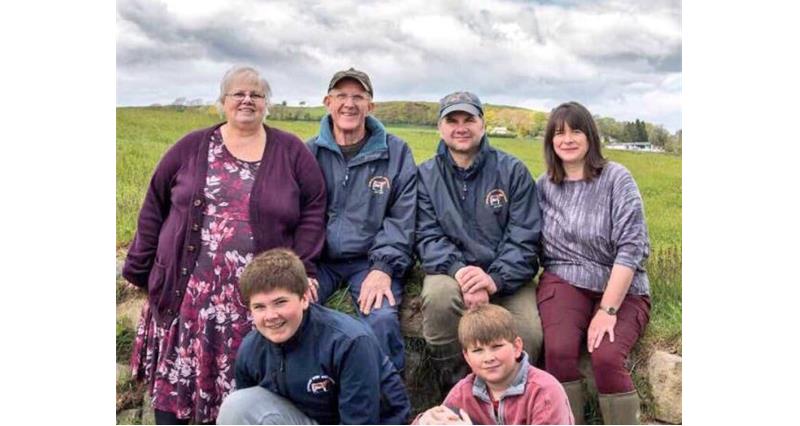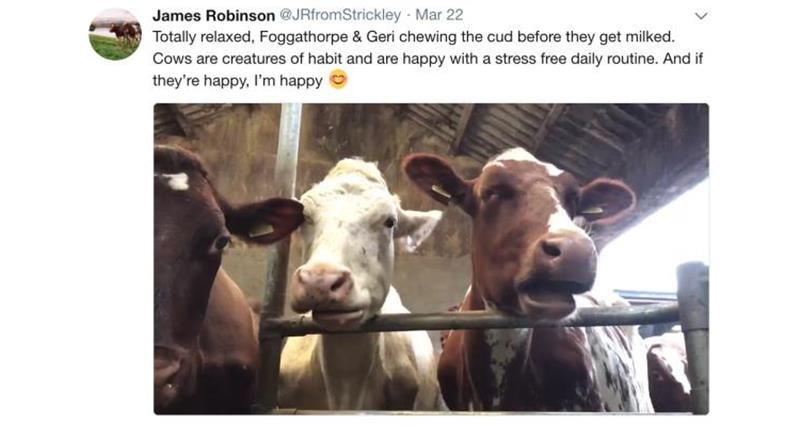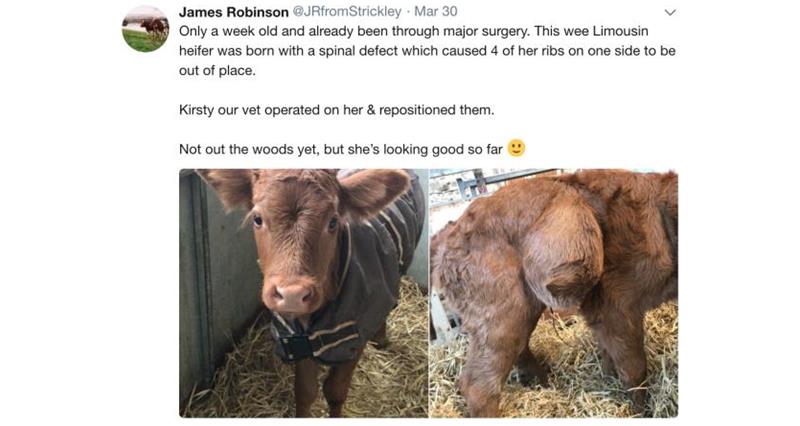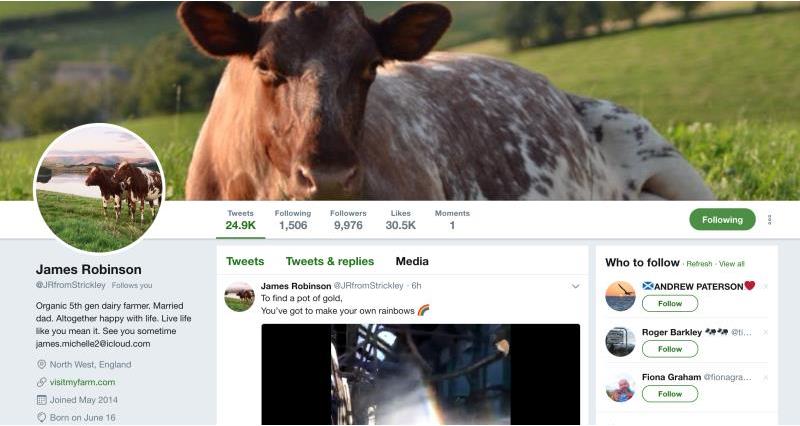And while many news stories focus on the negative aspects of such social sharing, the real story lies with how we can utilise the platforms for our benefit - to share honest and truthful information in a world intent on viewing industries such as agriculture through falsities and rose tinted glasses.
One such farmer intent on portraying the realism of farming through Twitter is James Robinson, a fifth generation organic dairy farmer from Kendal in Cumbria.
Posting under the handle of @JRfromStrickley James has grown his social media following since joining the platform about three and a half years ago.
“I had never done anything like this, I honestly didn’t think social media would be for me - why would people want to know about what I was doing,” questioned James who now has 9,962 followers on his Twitter account.
“I first joined Twitter because I needed some opinions on a problem I had. I Googled the issue and the results showed people asking similar questions on Twitter.
“And that’s how my Twitter story started. Everything has just developed from there.”
Helping Rural Isolation
In 2016, Twitter had more than 319 million monthly active users, creating one big Tweeting community, expanding social networks throughout the world.
With so much work going into breaking the stigma of mental health on a national level, and organisations calling for more people to speak out about their mental state, providing a platform for discussion can help farmers working in isolated situations speak out to people in similar situations and help start conversations.
“Obviously, there is a social element to social media, and I have found that to be extremely positive on the most part,” explained James.
“Working out on the farm can be extremely isolating. You can be on your tractor for hours at a time, making no verbal contact with anyone except your dog.
James Robinson (third from left) with his family
“If you’re not careful you can become so caught up in your own bubble that something which could just be a small easily solvable issue could become something so much bigger, and for some, this could be too much to bear alone.
“For me at least, Twitter has provided a platform for me to speak to other farmers and I’ve met some very good friends whom I otherwise would never have met, all over the country.
“It’s just nice to know that when you’ve had a pretty rubbish day, you can put something on Twitter and you will get responses from people who totally understand and will have been there themselves.”
Educating the nation
What started as James talking to fellow farmers, posting pictures long time agriculturalists will sympathise with, has turned into more of an educational tool, helping to spread the positive, and truthful, farming message.
“In the last three years my Twitter stance has changed somewhat and I would say that about 50 per cent of my followers are now non-farmers interested in hearing about the industry from a grass roots worker.
“While you don’t want to show absolutely everything that happens on the farm, you also can’t shelter the public completely from the industry which is creating the food for their table and caring for the animals they see in the fields.
“I now target my tweets to the non-farmers and explain what I am doing and why this helps the industry. Explaining the importance of supporting British farmers rather than just saying it, and educating the next generation to ensure UK farmers receive support from all angles.”
However, it is no secret that using an open platform such as Twitter to promote farming gives the anti-farming brigade a platform to share their views as well. But for James, he doesn’t see this as such an issue.
“You may notice I do not use hashtags very often in my tweets. Hashtags are, in their primary function, a searching tool, and this is how the antis and the vegans who want to quash the real image of farming will find your account and knock you down.
“The response I have had from non-farmers has been absolutely fantastic. I’m constantly getting positive messages on how much they enjoy the pictures and my stories.”
Providing work
As well as providing a window into the farming world for non-farmers, James has found that Twitter can also be an excellent provider of work for those in the industry, or wanting to enter the industry as a new entrant.
“You’ve got a readymade network of contacts without having to leave your home, all looking for a little help here and there, and all happy to say yes to a quick favour.
“If someone needs assistance at lambing time, or someone is in need of a relief milker, they can put the message online and everyone pulls together to match them up with someone wanting some experience.”
Groups such as #TeamDairy and #ClubHectare have taken the Twitter world by storm. They have gone from a Twitter community to a fully-fledged members group, meeting up in person, creating events, and providing contacts all over the country for like-minded people.
Where next?
With the sheer amount of farming content appearing on Twitter these days, it’s difficult to put a figure on just how many farmers are on the platform sharing stories and pictures of ‘real life’ farming.
“It is very much like a diary - both a farm diary and a personal one.
“You can look back and see what day you silaged last year, or when the cows were housed for winter. And if you are personal with your tweets, you can read about what you were thinking a few years ago.
“It’s no different to the farm diaries my Grandad kept when he was a lad. The only difference is we just get to put a bit of colour in them with pictures and videos.”
For James, joining Twitter in 2014 has provided him with fun, interaction and a community of friends. Many farmers have since taken on the helm of storytelling online, and with Twitter’s membership constantly growing, who knows how this will continue to benefit the farming industry in the future.
“The key is showing there is a real person behind the tweets. I’m not a company being paid to share the positive message of this industry or hard selling products.
“It’s not all positive, we know that. But it’s about drip feeding the entire image of agriculture to people who may have no idea.
“If a non-farming person who follows my account can think twice when deciding whether to buy beef from the UK or elsewhere in the world, based on what they have seen on my account, then I’m doing a good thing.”
James’ Top Accounts
Will Evans, Wales - @willpenrievans - Developed his own podcasts with Rock and Roll Farming, and continues to be a fantastic farming advocate.
James Rebanks, Lake District - @herdyshepherd1 - has done incredibly well for himself through sharing his story on Twitter and is now the author of international best seller ‘The Shepherd’s Life’.
S.J Drummond, Ayrshire - @S_JDrummond - honest, hardworking farmers.
Jon Stanley, Dorset - @JonStanley10 - Great farming account showing the whole family getting involved.
Hannah Jackson, Cumbria - @redshepherdess - a great example of finding contacts through social media. Hannah’s a first-time farmer sharing her fun, trials and tribulations via Twitter.
Sam Pearson, Wales - @Sambrondanw - One of my favourite follows. New entrant and now share farmer. Sam is also a hard worker and a top bloke.
Farmers Of The UK, various - @FarmersOfTheUK - Each week a new farmer takes to the helm, sharing their stories and pictures. This is a fantastic insight into farming all over the country.
